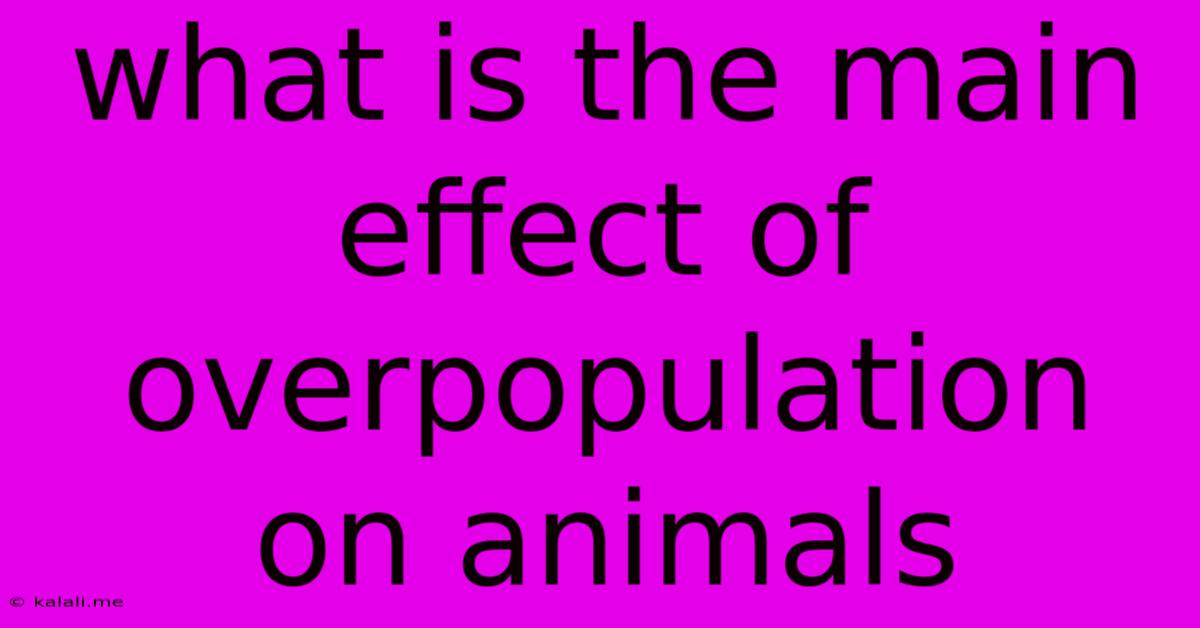What Is The Main Effect Of Overpopulation On Animals
Kalali
May 09, 2025 · 3 min read

Table of Contents
The Devastating Impact of Overpopulation on Animal Life
Overpopulation, the excessive growth of the human population beyond the carrying capacity of the environment, casts a long shadow on the animal kingdom. It's not just about crowding; it's about a complex web of interconnected effects that threaten biodiversity and ecosystem stability. This article explores the main effects of overpopulation on animals, highlighting the urgency of addressing this global challenge.
Habitat Loss and Fragmentation: The Primary Threat
Perhaps the most significant effect of overpopulation on animals is the rampant loss and fragmentation of habitats. As the human population expands, we encroach upon natural ecosystems—forests are cleared for agriculture and urbanization, wetlands are drained for development, and oceans are overfished. This leaves animals with less space to live, breed, and find food, leading to increased competition and ultimately, population decline. Fragmentation, the breaking up of continuous habitats into smaller, isolated patches, further exacerbates this problem, hindering gene flow and making populations more vulnerable to disease and environmental changes. Think of the impact on endangered species like orangutans in Borneo, whose habitat is shrinking rapidly due to deforestation.
Resource Depletion: A Struggle for Survival
Overpopulation leads to the depletion of natural resources vital for animal survival. Increased demand for food, water, and energy intensifies pressure on ecosystems. Overgrazing by livestock can degrade pastures, reducing food availability for herbivores. Water scarcity affects all species, leading to conflict and competition for limited resources. The extraction of resources like timber and minerals often disrupts habitats and causes pollution, adding another layer of stress on animal populations. This resource scarcity is particularly damaging for specialized species with limited dietary needs or specific habitat requirements.
Pollution: A Silent Killer
Human activities associated with overpopulation generate various forms of pollution that significantly harm animals. Air pollution from vehicles and industries can cause respiratory problems and weaken immune systems. Water pollution from industrial discharge, agricultural runoff, and sewage contaminates drinking water sources and harms aquatic life. Plastic pollution, a pervasive problem, entangles animals, chokes them, and contaminates their food sources. Noise pollution from human activities disrupts animal communication and behavior, hindering their ability to find mates, hunt, and avoid predators. The cumulative effect of these pollutants can be devastating to animal health and survival.
Climate Change: An Exacerbating Factor
Overpopulation significantly contributes to climate change, which further amplifies the negative impacts on animals. Increased greenhouse gas emissions from human activities accelerate global warming, leading to changes in weather patterns, sea levels, and ocean acidification. These changes disrupt ecosystems, force species migrations, and increase the vulnerability of animals to extreme weather events. Coral bleaching, a direct consequence of ocean warming, devastates coral reefs and the countless species that depend on them.
Increased Human-Wildlife Conflict:
As human populations expand into areas previously inhabited by wildlife, conflict between humans and animals increases. Animals might raid crops or livestock in search of food, leading to retaliatory killings. Expanding infrastructure can also isolate animal populations, leading to inbreeding and reduced genetic diversity. This conflict poses a serious threat to both human safety and animal populations.
Conclusion: A Call for Action
The effects of overpopulation on animals are multifaceted and devastating. Addressing this challenge requires a multifaceted approach, including promoting sustainable development, protecting and restoring habitats, reducing pollution, mitigating climate change, and fostering responsible resource management. The future of biodiversity depends on our ability to curb population growth and create a harmonious coexistence between humans and the animal kingdom. Ultimately, protecting animal life is essential for maintaining the health and stability of our planet.
Latest Posts
Related Post
Thank you for visiting our website which covers about What Is The Main Effect Of Overpopulation On Animals . We hope the information provided has been useful to you. Feel free to contact us if you have any questions or need further assistance. See you next time and don't miss to bookmark.